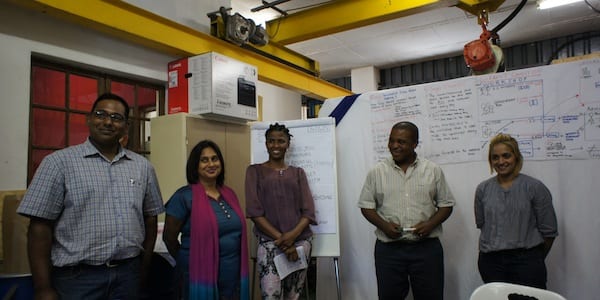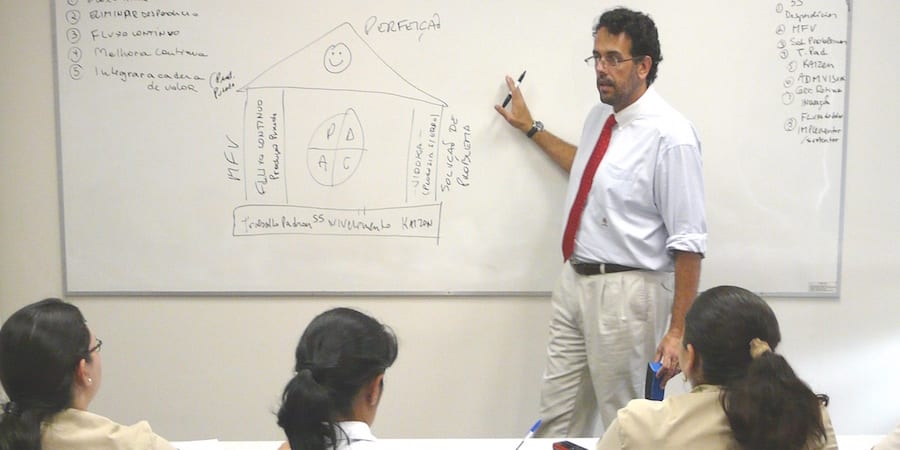
Bringing lean thinking upstream for a better supply chain
FEATURE - Norman Faull, Director of Lean Institute Africa, talks about a supplier development project the institute took part in, and shares a few of the results achieved.
Words: Norman Faull, Director, Lean Institute Africa
In 2011 Lean Institute Africa was seeking a host company for a new factory-based course with our long-time sensei, Furuhashi-san. The course, based on his work with Indian automotive suppliers over the previous four years, seemed ideally suited to the South African motor industry.
So I approached AID [a pseudonym], a provincial government funded agency established ‘to assist in increasing the global competitiveness of the South African automotive industry to world-class levels.’
Though unsuccessful in recruiting a host at that time, AID and LIA entered into a conversation that bore fruit of a different kind: I visited India in February 2012 to shadow Furuhashi-san for a week; in September 2012 AID took a delegation to India for two weeks for a broader look at industry-supporting initiatives there. And between those visits AID and LIA initiated an experiment based on earlier work with Furuhashi-san, a series of Rapid Process Improvement Workshops (RPIWs) for cohorts of auto industry suppliers.
The agreement between AID and LIA was based on a proposal along the lines shown here.

Participating companies understood that following the RPIW each would undertake their own improvement initiative with occasional on-site support from an AID consultant, an interim report-back six weeks after the RPIW and a final report-back and presentation another six weeks later.
The initiative was framed as a competition: participating companies would present the results of their respective improvement initiatives three months after the four-day RPIW with the best winning a glass trophy engraved with their accomplishment. Other conditions were that completing participants would receive a certificate and no fee would be charged.
At the core of the RPIWs is the A3 problem solving structure: Title (What are you talking about?), Background (Context, and why are you talking about this?), Current condition, Target condition, Analysis of causes of the gap between current and target conditions, Countermeasures, Plan and Follow-up.
Only the structure was taught, and required in tackling the workplace projects; the A3 paper size was not introduced. Teams would use flip chart sheets to write up against each heading. By photographing these and incorporating them into PowerPoint presentations, the groups were able to both develop their projects without being bogged down in computer use, and make an effective, concise presentation at the end of the workshop. In some cases the presentations were simply made from the flip chart sheets.
The first three RPIWs all took place at tier one suppliers to the auto industry; the first took place from in April 2012. There were five participating companies including the host and AID, and 12 participants. Three projects were undertaken, as summarized in here.

The projects finally presented three months later were of indifferent quality and the host company won the glass trophy for the press line project.
The second RPIW ran in August, had five participating companies including AID, who had now put forward ST [a presudonym for the AID manager who took part in the project] to be trained to run the RPIWs himself. In total there were eight delegates. Two projects were undertaken, in packing of parts and accessories (P&A), and a parts paint line. In the end, the host company again won the trophy for work on the P&A line.
The third RPIW ran in early October, had six participating companies including AID, and 14 delegates in total. Three projects were undertaken: stores receiving cycle time, stores retrieval time in supplying parts to the line, and the productivity of a particular part through brazing. The host company declared insolvency before the final presentations took place. Thereafter AID battled unsuccessfully to find a fourth host company to complete the contractual arrangement with LIA by the end of 2012. However, one success was that ST, early in 2013, ran his own successful RPIW with an automotive supplier.
THE PROJECT BECOMES MORE AMBITIOUS AS IT SEEKS FURTHER HOST COMPANIES
In early 2013 TNET [a pseudonym for a major South African parastatal, a state-owned enterprise which competes in the commercial sphere] announced a capital expansion program of around $100 billion over the next seven years. Furthermore, it stated the desire to develop South African suppliers during this period to ‘avoid leakage out of Africa’ of the capital spend. Even prior to the announcement, the purchasing department of TNET was known to have as objectives supplier development, economic growth, and transformation (i.e. transforming the South African economy from being predominantly dominated, both from an ownership and management perspective, by white males, towards a situation more representative of the national demographics – a key post-apartheid imperative of the national government.)
It was in this context that the purchasing department of TNET’s head office agreed with AID to test lean as a means of improving suppliers, initially through a hastily organised ‘pilot’ in a small owner-managed fabrication plant employing about 20 people. This ran in April 2013.
There were 11 delegates from six companies, including TNET, AID and the host. However, it was clear the TNET representatives were merely observers. The four supplier companies were all TNET suppliers and clearly hoped to curry favour with the giant company by attending the course at TNET’s invitation.
At the opening session I asked if anyone had heard of 5S, and was greeted with blank stares. Clearly we were now dealing with smaller and less sophisticated companies than those we had worked with in the automotive sector.
Two projects were undertaken during the RPIW: costing for quotation purposes, and welding throughput. But no great progress was made during the four days, with the host company often not able (or willing?) to answer questions or make personnel available for discussion.
However, the feedback forms completed on the fourth day scored ‘5s’ on virtually every question (the top option). The interim report-back took place in May at the hosting premises. Two of the participating companies had undertaken projects, with ST providing occasional visits, which showed significant benefits in cost reduction and quality improvement respectively.
Two weeks before the final presentations were due to take place, senior representatives of TNET met with AID managers and myself. The progress to date was discussed, along with lessons learned. A rough guide to expanding the program was outlined. It was agreed that the final presentations should take place at the TNET head office in downtown Johannesburg on 21 June – a venue sure to challenge the participating companies to put forward their best efforts.
So it was interesting when the host company did not pitch!
However, two of the companies showed real evidence of improvements achieved in specific areas in their companies over the previous three months. The winning company had made great strides in improving compliance quality and improved yield through close attention to jigs and how they were set up, calibrated and stored. Two memorable aspects of this presentation were the telling off the company gave TNET for the difficulties it creates for its suppliers, and the statement that a major lesson learnt was “to discuss the problem at the problem.” The other success story involved awareness of ‘flow’ dawning on the company and the steps taken resulting in lower WIP, more available space, and better throughput. ST reported to the meeting that, based on his gemba visits, the companies had achieved far more than they were able to report in the day’s format. See Picture 1 for more detail.
The senior managers from TNET attending the presentations were clearly pleased with what they had reported to them. They agreed to take the next step in using the ‘RPIW + support for three months’ program forward. Negotiations for the contract were protracted and settled on a further four RPIWs, each with a maximum of 15 participants, including three trainees ‘Master Facilitators’ (of the RPIW program) from within TNET itself to take over from the LIA/AID team in due course, building independent capacity to use the approach for ongoing supplier and small enterprise development.
The new series of RPIWs ran with a significant change: instead of a four-day RPIW, there would be a two-day introduction, and another two days a fortnight later. This was to enable owners and directors of these really small supplier companies to attend. To have the owner away from the business for four consecutive days, and give focused attention, seemed a challenge to attendance at all, and effective attendance at least. Picture 2 reports two of the three projects undertaken by the company hosting the first RPIW of the new series. Picture 3 reports two of the projects undertaken by attending non-host companies.
THE LESSONS WE LEARNED
- Support functions, like costing, preparing tenders, and materials requisitions form a common thread through the problems most vexing the owners of these small manufacturing concerns. The manufacturing itself does not seem to be of immediate concern for many, though clearly much waste is present there too.
- Although TNET is wanting to develop these small manufacturers and mature them to bigger and better things, it actually causes them significant problems, some of which even threaten their survival! The way it puts out requests for quotations and then awards much smaller quantities, and the way it puts out ‘lumpy’ requests for supply once the tender has been awarded create real challenges. The presentations have given the companies a legitimate platform to tell TNET what it is like to be a supplier.
- It took the participants a few hours to realize that this course was about doing, and not classroom based. Once that took root, they were strongly engaged. As hands-on, practical business people, they were helpful to the host company in making helpful observations. The initial ‘naivety’ regarding basic lean tools and thinking actually seemed an advantage as they quickly embraced concepts, like the ‘gemba’ comment that they now “discussed the problem at the problem.”
- We struggled to get them to go see without jumping to quick fixes about problems they had not yet properly examined/understood. ST created an imaginary ‘cookie jar’ into which one had to drop $1 should you make a proposal about a fix in the first two days of the workshop. It caught our imagination and was an effective reminder of the necessity to grasp the situation before considering countermeasures. We also used the analogy of the specific workplace problem area being like a crime scene and that good managers would approach the area just as a really good detective would, observing carefully, collecting factual evidence, looking for patterns, not jumping to conclusions – not even as to the nature of the crime. We invoked the image of Detective Columbo!
- The small businesses’ owners need to receive more motivation, both positive and negative, to get more consistent commitment and disciplined engagement. TNET will consider making it a qualifying condition of being allowed to tender for work that a company accepts an invitation to participate in such a program within two years, for example, of receiving that invitation.
- The second RPIW in the new series is half way. The two trainee facilitators of TNET have shown greatly improved confidence, insight and enthusiasm in supporting the process. They are being asked to take on more of the leading, although both are still positioned within host company projects. One is showing overt leadership in the group, the other is more supportive and low-key. It will be interesting to see who turns out the more effective.



THE AUTHOR

Read more


CASE STUDY – How do you keep up with a market changing at the speed of light? The Chief Inventor of an Australian digital company explains how they are using lean to safeguard their future.


PROFILE – It isn’t every day that you come across a hospital CEO coaching people on A3s and following his own standard work. So when you do, it’s important to share their story. This month we profile the CEO of a Brazilian cancer treatment center.


WOMACK’S YOKOTEN – What does a lean employer look like? In this month’s column, the author reflects on the long-term commitment to employees a company engaged in lean thinking should make.


FEATURE – Philips has embarked in an ambitious development program for lean executives, which is helping the organization make substantial progress in their transformation.

